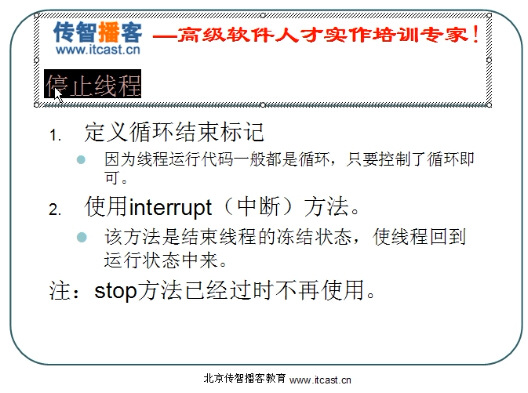线程间通讯:
其实就是多个线程在操作同一个资源,
但是操作的动作不同。
class Res
{
String name;
String sex;
boolean flag = false//默认值即为假。
}
class Input implements Runnable
{
private Res r;
Input(Res r)
{
this.r = r;
}
public void run()
{
int x = 0;
while(true)
{
synchronized(r)
{
if(r.flag)
try{wait();}catch(Exception e){}
if(x==0)
{
<span style="white-space:pre"> </span>r.name="mike";
<span style="white-space:pre"> </span> r.sex="man";
}
else
{
<span style="white-space:pre"> </span>r.name="丽丽";
<span style="white-space:pre"> </span>r.sex="女女女";
}
x = (x+1)%2;
<span style="white-space:pre"> </span>r.flag = true;
<span style="white-space:pre"> </span>notify();
}
}
}
}
class Output implements Runnable
{
private Res r;
Output(Res r)
{
this.r = r;
}
public void run()
{
while(true)
{
synchronized(r)
{
if(!r.flag)
try{wait();}catch(Exception e){}
System.out.println(r.name+"..."+r.sex);
r.flag = false;
notify();
}
}
}
}
class InputOutputDemo
{
public static void main(String[] args)
{
Res r = new Res();
Input in = new Input(r);
Output out = new Output(r);
Thread t1 = new Thread(in);
Thread t2 = new Thread(out);
t1.start();
t2.start();
}
}//notifyAll();唤醒所有
/*
wati;
notify();
notifyAll();
都使用在同步中,因为要对持有监视器(锁)的线程操作。
所以要使用在同步中,因为只有同步才具有锁。
为什么这些操作线程的方法要定义在Object类中呢?
因为这些方法在操作同步中线程时,都必须要标他们所操作线程持有的锁
只有同一个锁上的被等待线程,可以被同一个锁上的notify唤醒。
不可以对不同锁中的线程进行唤醒。
也就是说,等待和唤醒必须是同一个锁。
而锁可以是任意对象,所以可以被任意对象调用的方法定义在Object类中。
优化一下以上程序
class Res
{
private String name;
private String sex;
private boolean flag = false//默认值即为假。
public synchronized void set(String name,String sex)
{
if (flag)
{
try{this.wait();}catch(Exception e){}
}
this.name = name;
this.sex = sex;
flag = true;
this.notify;
}
public void out()
{
if (!flag)
try{this.wait();}catch(Exception e){}
System.out.println(name+"...."+sex);
flag = false;
this.notify();
}
}
class Input implements Runnable
{
private Res r;
Input(Res r)
{
this.r = r;
}
public void run()
{
int x = 0;
while(true)
{
if(x==0)
r.set("mike","man");
else
r.set("丽丽","女女女女女");
x = (x+1)%2;
}
}
}
class Output implements Runnable
{
private Res r;
Output(Res r)
{
this.r = r;
}
public void run()
{
while(true)
{
r.out();
}
}
}
class InputOutputDemo2
{
public static void main(String[] args)
{
Res r = new Res();
new Thread(new Input(r)).start();//匿名对象形式简化下面语句
new Thread(new Output(r)).start();
/* Input in = new Input(r);
Output out = new Output(r);
Thread t1 = new Thread(in);
Thread t2 = new Thread(out);
t1.start();
t2.start();
*/
}
}生产者消费者
class ProducerConsumerDemo
{
public static void main(String[] args)
{
Resource r = new Producer();
producer pro = new Producer(r);
Consumer con = new Consumer(r);
Thread t1 = new Thread(pro);
Thread t2 = new Thread(pro);
Thread t3 = new Thread(con);
Thread t4 = new Thread(con);
t1.start();
t2.start();
t3.start();
t4.start();
}
}
/*
对于多个生产者和消费者。
为什么要定义while判断标记。
原因:让被唤醒的线程再一次判断标记。
为什么定义notifyAll
因为需要唤醒对方线程。
因为只用notify容易出现只唤醒本方线程的情况。导致程序中的所有线程都等待。
*/
class Resource
{
private String name;
private int count = 1;
private boolean flag = false;
public synchronized void set(String name)
{
while(flag)
try{wait()}catch(Exception e){}
this.name = name+"--"+count++;
System.out.println(Thread.currentThread().getName()+"...生产者..."+this.name);
flag = true;
this.notifyAll();
}
public synchronized void out()
{
while(!flag)
try{wait();}catch(Exception e){}
System.out.println(Thread.currentThread().getName()"...消费者..."+this.name);
flag = false;
this.notifyAll();
}
}
class Producer implements Runnable
{
private Resource res;
Producer(Resource res)
{
this.res = res;
}
public void run()
{
while(true)
{
res.set("+商品+");
}
}
}
class Cunsumer implements Runnable
{
private Resource res;
Consumer(Resource res)
{
this.res = res;
}
public void run()
{
while(true)
{
res.out();
}
}

JDK5.0升级版
import java.util.concurrent.locks.*;
class ProducerConsumerDemo2
{
public static void main(String[] args)
{
Resource r = new Producer();
producer pro = new Producer(r);
Consumer con = new Consumer(r);
Thread t1 = new Thread(pro);
Thread t2 = new Thread(pro);
Thread t3 = new Thread(con);
Thread t4 = new Thread(con);
t1.start();
t2.start();
t3.start();
t4.start();
}
}
/*
<strong>JDK1.5中提供了多线程升级解决方案。(显示的锁机制以及显示的锁对象上的等待唤醒操作机制。一个锁可以有多组condition对象。)
将同步Synchronized替换成现实Lock操作。
将Object中的wait,notify,notifyAll,替换了Condition对象。
该对象可以Lock锁 进行获取。
该示例中,实现了本方只唤醒对方操作。</strong>
*/
class Resource
{
private String name;
private int count = 1;
private boolean flag = false;
private Lock lock = new ReentrantLock();
private Condition condition_pro = lock.newCondition();
private Condition condition_con = lock.newCondition();
public void set(String name)throws InterruptedException
{
lock.lock();
try
{
while(flag)
condition_pro.await();//t1,t2
this.name = name+"--"+count++;
System.out.println(Thread.currentThread().getName()+"...生产者..."+this.name);
flag = true;
condition_con.signal();
}
finally
{
lock.unlock();//释放锁的动作一定要执行。
}
}
// t3 t4
public void out()throws InterruptedException
{
lock.lock();
try
{
while(!flag)
condition_con.await();
System.out.println(Thread.currentThread().getName()"...消费者..."+this.name);
flag = false;
condition_pro.signal();
}
}
}
class Producer implements Runnable
{
private Resource res;
Producer(Resource res)
{
this.res = res;
}
public void run()
{
while(true)
{
res.set("+商品+");
}
}
}
class Cunsumer implements Runnable
{
private Resource res;
Consumer(Resource res)
{
this.res = res;
}
public void run()
{
while(true)
{
res.out();
}
}
stop方法已经过时。
如何停止线程?
只有一种,run方法结束。
开启多线程运行,运行代码通常是循环结构。
只要控制住循环,就可以让run方法结束,也就是线程结束。
特殊情况:
当线程出于冻结状态。
就不会读取到标记。那么线程就不会结束。
当没有指定的方式让冻结的线程恢复到运行状态时,这时需要对冻结状态进行清除。
强制让线程恢复到运行状态中来,这样就可以操作标记让线程结束。
Thread类提供了该方法:Interrupt();(sleep,wait,join都能唤醒)
class StopThread implements Runnable
{
private boolean flag = true;
public synchronized void run()
{
while(flag)
{
try
{
wait();
}
catch (InterruptedException e)
{
System.out.println(Thread.currentThread().getName()+"...Exception");
}
System.out.println(Thread.currentThread().getName()+"...run");
}
}
public void changeFleg()
{
flag = false;
}
}
class StopThreadDemo
{
public static void main(String[] args)
{
StopThread st = new StopThread();
Thread t1 = new Thread(st);
Thread t2 = new Thread(st);
t1.setDaemon(true);//<strong>守护线程</strong>
t2.setDaemon(true);
t1.start();
t2.start();
int num = 0;
while(true)
{
if(num++ ==60);
{
//st.changeFlag();
<span style="white-space:pre"> </span>//t1.interrupt();
<span style="white-space:pre"> </span>//t2.interrupt();<span style="white-space:pre"> </span> break;
}
System.out.println(Thread.currentThread().getName()+"....."+num);
}
System.out.println("over");
}
}join:
当A线程执行到了B线程的.join()方法时,A就会等待。等B线程执行完,A才会执行。
join可以用来临时加入线程执行。
class Demo implements Runnable
{
public void run()
{
for(int x = 0; x<70; x++)
{
System.out.println(Thread.currentThread().getName()+"..."+x);
}
}
}
class JoinDemo
{
public static void main(String[] args) throws Exception
{
Demo d = new Demo();
Thread t1 = new Thread(d);
Thread t2 = new Thread(d);
t1.start();
t1.join();//t1抢夺CPU执行权
t2.start();
for (int x = 0; x<80 ; x++ )
{
System.out.println("main....."+x);
}
System.out.println("over");
}
}线程的优先级,时停止yield()
class Demo implements Runnable
{
public void run()
{
for(int x = 0; x<70; x++)
{
System.out.println(Thread.currentThread().getName()+"..."+x);
Thread.yield();//稍微减缓线程运行,暂时停止。
}
}
}
class JoinDemo
{
public static void main(String[] args) throws Exception
{
Demo d = new Demo();
Thread t1 = new Thread(d);
Thread t2 = new Thread(d);
t1.start();
t1.setPriority(Thread.MAX_PRIORITY);//设置优先级,默认值为5,范围1-10。MAX,MIN,NORM
//t1.join();
t2.start();
for (int x = 0; x<80 ; x++ )
{
System.out.println("main....."+x);
}
System.out.println("over");
}
}技巧写法,用匿名内部类
class ThreadTest
{
public static void main(String[] args)
{
new Thread()
{
public void run()
{
for(int x=0; x<100; x++)
{
System.out.println(Thread.currentThread().getName()+"....."+x);
}
}
}.start();
for(int x=0; x<100; x++)
{
System.out.println(Thread.currentThread().getName()+"...."+x);
}
Runnable r = new Runnable()
{
public void run()
{
for(int x=0; x<100; x++)
{
System.out.println(Thread.currentThread().getName()+"...."+x);
}
}
};
new Thread(r).start();
//new Test1().start();
}
}
/*
class Test1 extends Thread
{
public void run()
{
for(int x=0; x<100;x++)
{
System.out.println(Thread.currentThread().getName()+"...."+x);
}
}
}
*/






















 被折叠的 条评论
为什么被折叠?
被折叠的 条评论
为什么被折叠?








